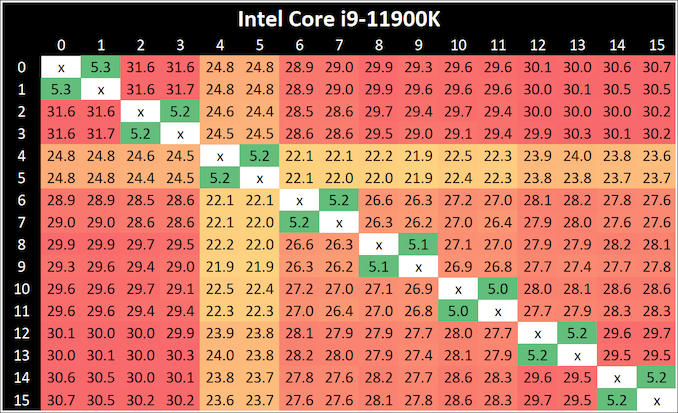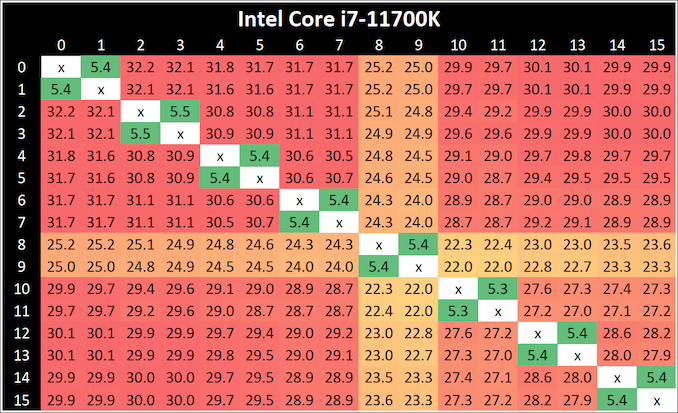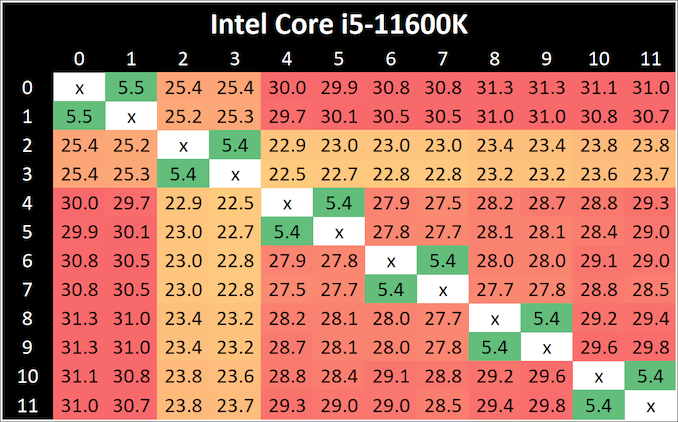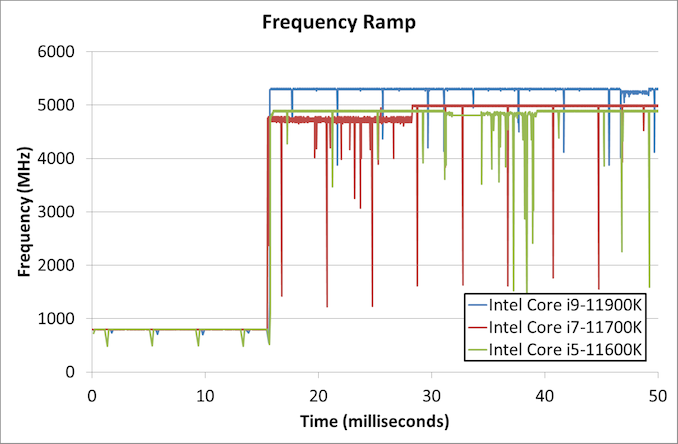Intel Rocket Lake (14nm) Review: Core i9-11900K, Core i7-11700K, and Core i5-11600K
by Dr. Ian Cutress on March 30, 2021 10:03 AM EST- Posted in
- CPUs
- Intel
- LGA1200
- 11th Gen
- Rocket Lake
- Z590
- B560
- Core i9-11900K
CPU Tests: Microbenchmarks
Core-to-Core Latency
As the core count of modern CPUs is growing, we are reaching a time when the time to access each core from a different core is no longer a constant. Even before the advent of heterogeneous SoC designs, processors built on large rings or meshes can have different latencies to access the nearest core compared to the furthest core. This rings true especially in multi-socket server environments.
But modern CPUs, even desktop and consumer CPUs, can have variable access latency to get to another core. For example, in the first generation Threadripper CPUs, we had four chips on the package, each with 8 threads, and each with a different core-to-core latency depending on if it was on-die or off-die. This gets more complex with products like Lakefield, which has two different communication buses depending on which core is talking to which.
If you are a regular reader of AnandTech’s CPU reviews, you will recognize our Core-to-Core latency test. It’s a great way to show exactly how groups of cores are laid out on the silicon. This is a custom in-house test built by Andrei, and we know there are competing tests out there, but we feel ours is the most accurate to how quick an access between two cores can happen.
All three CPUs exhibit the same behaviour - one core seems to be given high priority, while the rest are not.
Frequency Ramping
Both AMD and Intel over the past few years have introduced features to their processors that speed up the time from when a CPU moves from idle into a high powered state. The effect of this means that users can get peak performance quicker, but the biggest knock-on effect for this is with battery life in mobile devices, especially if a system can turbo up quick and turbo down quick, ensuring that it stays in the lowest and most efficient power state for as long as possible.
Intel’s technology is called SpeedShift, although SpeedShift was not enabled until Skylake.
One of the issues though with this technology is that sometimes the adjustments in frequency can be so fast, software cannot detect them. If the frequency is changing on the order of microseconds, but your software is only probing frequency in milliseconds (or seconds), then quick changes will be missed. Not only that, as an observer probing the frequency, you could be affecting the actual turbo performance. When the CPU is changing frequency, it essentially has to pause all compute while it aligns the frequency rate of the whole core.
We wrote an extensive review analysis piece on this, called ‘Reaching for Turbo: Aligning Perception with AMD’s Frequency Metrics’, due to an issue where users were not observing the peak turbo speeds for AMD’s processors.
We got around the issue by making the frequency probing the workload causing the turbo. The software is able to detect frequency adjustments on a microsecond scale, so we can see how well a system can get to those boost frequencies. Our Frequency Ramp tool has already been in use in a number of reviews.
From an idle frequency of 800 MHz, It takes ~16 ms for Intel to boost to the top frequency for both the i9 and the i5. The i7 was most of the way there, but took an addition 10 ms or so.














279 Comments
View All Comments
arashi - Wednesday, March 31, 2021 - link
Calm down Piednoel, Intel isn't going to hire you as CEO after Pat leaves either way.Qasar - Wednesday, March 31, 2021 - link
he's just a very angry person for some reason, let him be, maybe he will just get tired of whining, and go somewhere else.Oxford Guy - Thursday, April 1, 2021 - link
Ad hominem much?AlyxVariant - Wednesday, March 31, 2021 - link
From 10nm to 14nm...Why?.... Why Intel...
But What about iGPU tests?
The known YouTube Sdfx Show prove that at mid/low range game config the Iris iGPU can game at solid 60FPS
TheinsanegamerN - Wednesday, March 31, 2021 - link
This isnt an iris GPU and pales in comparison to AMD's vega."gaming at solid 60 FPS" I could load up shovel knight on an atom netbook at game at a "solid 60 FPS". Doesnt mean the netbook is any good. Intel's desktop GPUs suck. 32 EUs (24 for the i5 10400) VS the 96 EU+64MB cache of tiger lake.
JimmyZeng - Thursday, April 1, 2021 - link
Please compare 5800X to 11700KF instead of 11700K, you're anandtech, don't make such rookie mistakes.Bagheera - Thursday, April 1, 2021 - link
you know the KF chips still have the iGPU on-die, just disabled, right? one can simply disable the iGPU on the K and it would be the same??Hifihedgehog - Thursday, April 1, 2021 - link
Shhh... Piednoel will spend a whole evening again writing pages of nonsense here if you egg him on.Bagheera - Saturday, April 10, 2021 - link
the KF is lower price, so if someone wanted to save some money and don't need the iGPU they can go for that part. but for performance review K and KF are effectively identical. there's nothing wrong with comparing the K against the 5800X.JimmyZeng - Friday, April 2, 2021 - link
But why? Intel provides KF SKUs at a lower price tag, do not forget that.